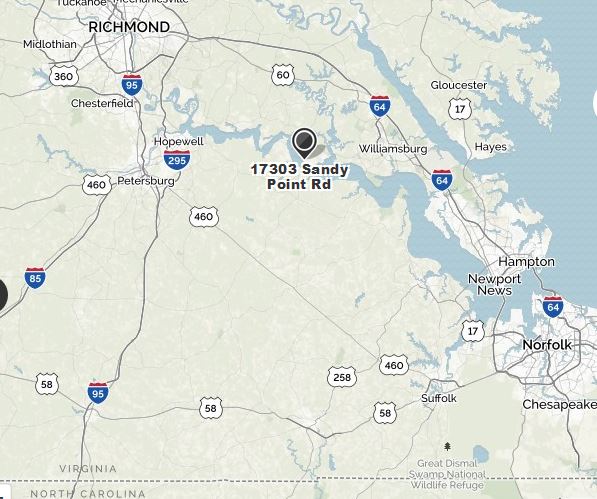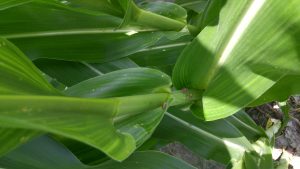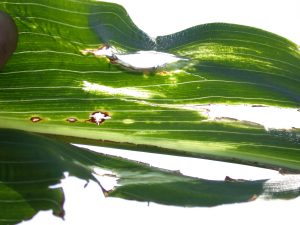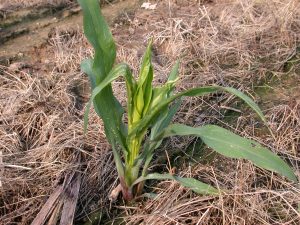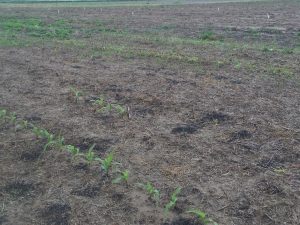Due to impending rain Tuesday and Wednesday and already saturated soils, the Eastern Shore AREC field day scheduled for Wednesday, September 13, 2017 has been canceled. Let’s hope Hurricane Irma keeps tracking further west. We certainly do not need any more rain!
Category Archives: Field Corn
Eastern Shore AREC Field DAY: September 13th, 2017
Please join us for Virginia Tech’s Eastern Shore Agricultural Research and Extension Center (ESAREC) 2017 Research Field Day on Wednesday, September 13th. Registration is free, open to the public and will begin at 8:00 AM at the ESAREC complex located at 33446 Research Drive, Painter, Virginia 23420. The field tour will begin at 9:00 AM and conclude with lunch at 12:30 PM. See the attached flyer for specific projects to be highlighted and more information.
If you would like more information or are interested in sponsoring this event, please contact Lauren Seltzer at 757-414-0724 ext. 11 or email at mlpeyton@vt.edu.
What You’ll See in the Field at the Virginia Ag Expo
 As another reminder, the Virginia Ag Expo is Thursday, Aug. 3 at Renwood Farms in Charles City. The event opens at 7:30 am and will run through mid-afternoon.
As another reminder, the Virginia Ag Expo is Thursday, Aug. 3 at Renwood Farms in Charles City. The event opens at 7:30 am and will run through mid-afternoon.
There is something for all corn and soybean farmers in the field this year. Go on the field tour and you will be able to chat with Extension Specialists, company reps, and others about the research being conducted or anything else on your mind.
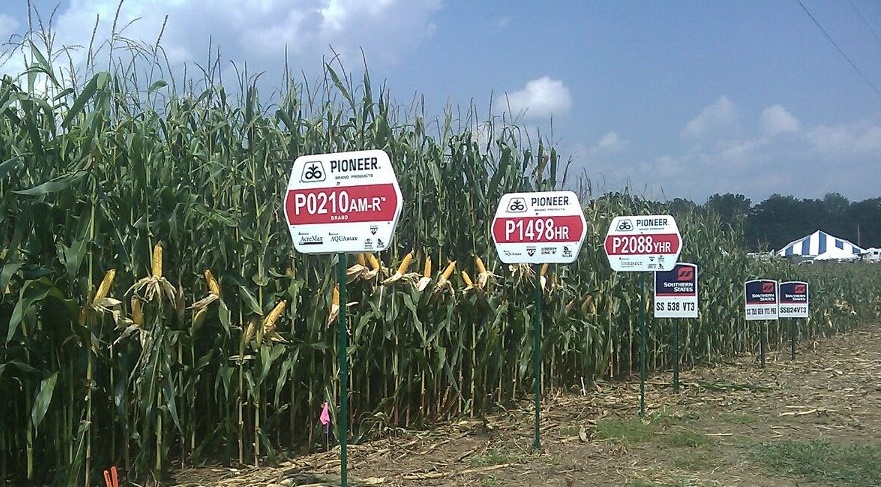 As always, the Ag Expo is home of one of our numerous on-farm corn hybrid and soybean variety tests. This year, you will view 31 corn hybrids from 11 companies and 47 soybean varieties from 14 companies. Drs. Mike Flessner and Charlies Cahoon will demonstrate off-site herbicide injury with some of our newest seed/chemical technologies. Dr. Wade Thomason is evaluating in-furrow and starter fertilizer in corn. The soil fertility team, led by Dr. Mark Reiter, is investigating fertilizer recommendations to ensure optimum production for high yielding soybeans. You will view one of Dr. David Holshouser’s seeding rate trials as he is in the process of establishing variable rate seeding recommendations. You will also see an experiment that you may have viewed at last year’s Ag Expo investigating the interaction of planting date with relative maturities. Companies are participating in our plots with in-furrow and foliar sprays that offer potential to enhance yield potential under high-yielding conditions. Finally, you’ll go below ground to view Virginia’s state soil, a Pamunkey loam, and discuss this yield contest-winning properties with NRCS personnel.
As always, the Ag Expo is home of one of our numerous on-farm corn hybrid and soybean variety tests. This year, you will view 31 corn hybrids from 11 companies and 47 soybean varieties from 14 companies. Drs. Mike Flessner and Charlies Cahoon will demonstrate off-site herbicide injury with some of our newest seed/chemical technologies. Dr. Wade Thomason is evaluating in-furrow and starter fertilizer in corn. The soil fertility team, led by Dr. Mark Reiter, is investigating fertilizer recommendations to ensure optimum production for high yielding soybeans. You will view one of Dr. David Holshouser’s seeding rate trials as he is in the process of establishing variable rate seeding recommendations. You will also see an experiment that you may have viewed at last year’s Ag Expo investigating the interaction of planting date with relative maturities. Companies are participating in our plots with in-furrow and foliar sprays that offer potential to enhance yield potential under high-yielding conditions. Finally, you’ll go below ground to view Virginia’s state soil, a Pamunkey loam, and discuss this yield contest-winning properties with NRCS personnel.
This is a walking, go-at-your-own-pace tour designed to fit your interest and schedule. Buses will be running continuously to take you to and from the plots. Enjoy!

2017 Virginia Ag Expo Returns to Charles City County
Please note: the date for the Virginia Ag Expo is August 3, 2017.
“Focused on Productivity, Management and Stewardship” is the theme for the 2017 Virginia Ag Expo. The Virginia Ag Expo, hosted by the Virginia Grain Producers Association and the Virginia Soybean Association in partnership with Virginia Cooperative Extension, is the largest agricultural field day held in the Commonwealth of Virginia. As an educational, marketing and social event farmers and agribusiness look forward to the Virginia Ag Expo each year.
Renwood Farms, owned and operated by The Stanley Hula Family, will be hosting this year’s Ag Expo on August 3. The Hula Family’s farm is a diversified operation growing over 6,000 acres of corn, soybeans and small grains; along with seed conditioning and sales. A focus on management and productivity at Renwood Farms has produced the world record corn yield of 532 bushels per acre by David Hula. In addition, the USG soybean seed that produced the world record yield of 172 bushels per acre was grown and conditioned at Renwood Farms.
Over 150 exhibitors and sponsors will have on display all of the most up to date equipment, goods and services for agricultural producers and property owners no matter how large or small.
The event opens at 7:30 am. The field tour, starting at 8 am, is a walking, go-at-your-own-pace tour designed to fit your interest and schedule. Buses will be running continuously to take you to and from the plots.
Breakfast and lunch will be provided by Virginia food vendors. Attendees will be able to eat any time from 6:30 AM to 2:00 PM.
Renwood Farms is located at 17303 Sandy Point Road, Charles City, VA 23030.
Stink bug numbers continue to climb
Brown stink bug numbers have continued to increase in eastern Virginia from the Northern Neck to the Tidewater region. We have scouted fields in Suffolk and Caroline County with higher than threshold infestations spanning the entire field. Infestations in most fields remain confined to border rows and the majority of infested fields are near where wheat has been recently harvested.
Many growers are facing the decision to treat. Previously I had reported a threshold of 1 bug per 4 plants. In order to be extra protective during ear formation and elongation, treatment at the 1 bug per 10 plants threshold can be justified for heavily infested fields. More information about stink bugs in corn can be found here – NCSU corn stink bug management considerations.
The ability of stink bugs to injure corn depends heavily on corn growth stage. Trials at the Tidewater Research Station have shown that stink bug feeding does not always reach developing ears. The photo below shows a healthy ear developing (VT growth stage) despite multiple feeding lesions to the outside of the stalk. This may be good news for Virginia growers. We cannot determine if yield was effected in these plants until later this season.
This week, we will be rechecking fields that were treated with aerial applications and post updates on the effectiveness of these sprays.
Stink bug numbers increasing in corn
Coinciding with the wheat harvest, brown stink bugs have been moving into pre-tassel corn in the southeastern region of our Virginia. The entomology department has scouted fields over threshold in Chesapeake and Virginia Beach. So far this season, stink bugs are present in low numbers in northern, central, and western regions of the state.
Thresholds for stink bugs in field corn are (From Dominic Reisig at NCSU):
one stink bug per four plants during ear formation, elongation, and pollen shed
one stink bug per two plants nearing the end of pollen shed to the blister stage.
Plant injury from stink bugs may include:
Holes in leaves and, in severe cases, twisted plants.
It is important to remember that this bug typically infests on edges of fields and in spotty locations. It is possible, though unlikely, that stink bugs will infest an entire field. Spray volume is critical if you decide to spray – use a high volume to ensure that sprays penetrate the canopy. Insecticides labeled for stink bugs in corn (e.g., Baythroid XL, Karate Z, Warrior II) must come into direct contact with insects to kill them.
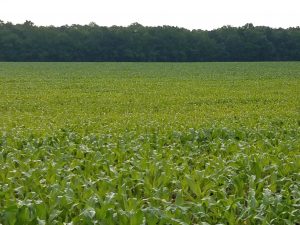
Yellow Corn in Virginia, Again.
For the second year in a row we are seeing many corn fields in Virginia experiencing stunted and yellow growth due to cool and wet growing conditions. See this publication for different causes of yellow and stunted corn and possible changes to your nitrogen applications for the first or second sidedress: Corn Fertility_2June2017
Failed Corn Stand: Starting Over
Charlie Cahoon and Michael Flessner
Virginia Tech Weed Science
Over the past few days we have had several questions concerning replanting corn behind an already failed corn stand. Our biggest concern in this situation is how to terminate emerged corn from the first planting. The best option for small corn (4-8 inch) is clethodim (Select Max or generics). The label for Select Max (0.97 lb active ingredient/gal) specifies 6 oz/A must be applied at least 6 day prior to replanting. Clethodim products that contain 2 lb active ingredient/gal and are labeled for this situation should be applied at 3 oz/A, while adhering to the same plant-back restriction. As is the case with many weeds, timeliness is critical. Control of larger corn by clethodim is variable (> 8 inches).
Producers not wanting to wait 6 days before replanting should use paraquat (at least 3 pt/A of a 2 lb/gal product or 2 pt/A of a 3 lb/gal product). Paraquat should not be used alone; adding atrazine (1 pt/A) and suggested adjuvants to paraquat will enhance control. Research conducted by Dr. Kevin Bradley (University of Missouri) and Larry Steckel (University of Tennessee) concluded Liberty did not consistently control Roundup Ready corn. Although not listed on the bag, many corn hybrids are tolerant to glufosinate (active ingredient in Liberty). For these reasons, producers should be wary of using Liberty to terminate a failed corn stand.
Another common question when replanting corn is whether to reapply residual herbicides such as atrazine. Atrazine and other residual herbicides should not be reapplied. If additional atrazine is desired in a postemergence application, just note that the cumulative total atrazine for your first and second planting of corn cannot exceed 2.5 lb active ingredient per acre per year. Other products have similar restrictions.
On a normal year, growers are usually asking if soybean can be planted behind corn. And our answer to this is usually no. This is mostly due to the fact that most everyone uses atrazine preemergence and planting soybean following atrazine if very risky. The label of most atrazine products says “Do not rotate to any crop except corn or sorghum until the following year, or injury may occur” and “If applied after June 10, do not rotate with crops other than corn or sorghum the next year, or crop injury may occur”.
Warm weather and grain bin insects
Our recent warm weather has done more than wake up your plants – it has signaled to many insects that it is time to start feeding and reproducing. Prompted by a call from ANR agent Mike Parrish in Dinwiddie County, I spoke today with Kathy Flanders at University of Auburn about her recommendations to mitigate insect injury in store grain. Her #1 suggestion – turn on those fans! Your goal should be to keep the temperature inside your bin below 60 degrees. Make sure and leave equipment running long enough to cool the entire structure. If you are unable to keep temperatures below this threshold, or if our nights do not stay cool, make sure to take samples regularly to scout for insect injury. Consult this guide for management recommendations specific to the Southeast: http://www.aces.edu/pubs/docs/I/IPM-0330/IPM-0330.pdf.
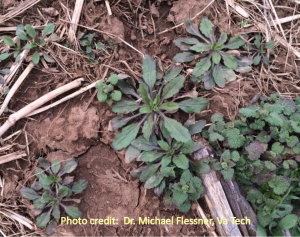
Scout now for marestail/horseweed
Recent mild temperatures and the mild winter are setting the stage for rapid development of marestail/horseweed (Conyza canadensis) this spring. Marestail was particularly troublesome last year in soybeans. Marestail can germinate in both the fall and the spring. It is more likely to overwinter in the rosette stage during mild winters. If you wait until your typical burndown the marestail may start bolting and therefore be more difficult to control. Adding to this difficulty, many marestail populations are resistant to Roundup (and other glyphosate containing products). You should scout your fields targeted for soybeans now to identify overwintering marestail. Marestail control can be achieved with 2,4-D or dicamba now and still offer plenty of time to avoid plant back restrictions (up to 15 days for 2,4-D or up to 28 days for dicamba). Glyphosate resistant weeds and the difficulty in controlling more mature weeds underscore the need to scout fields earlier and use some alternative herbicides in your program. Always consult the product label for specific instructions.


